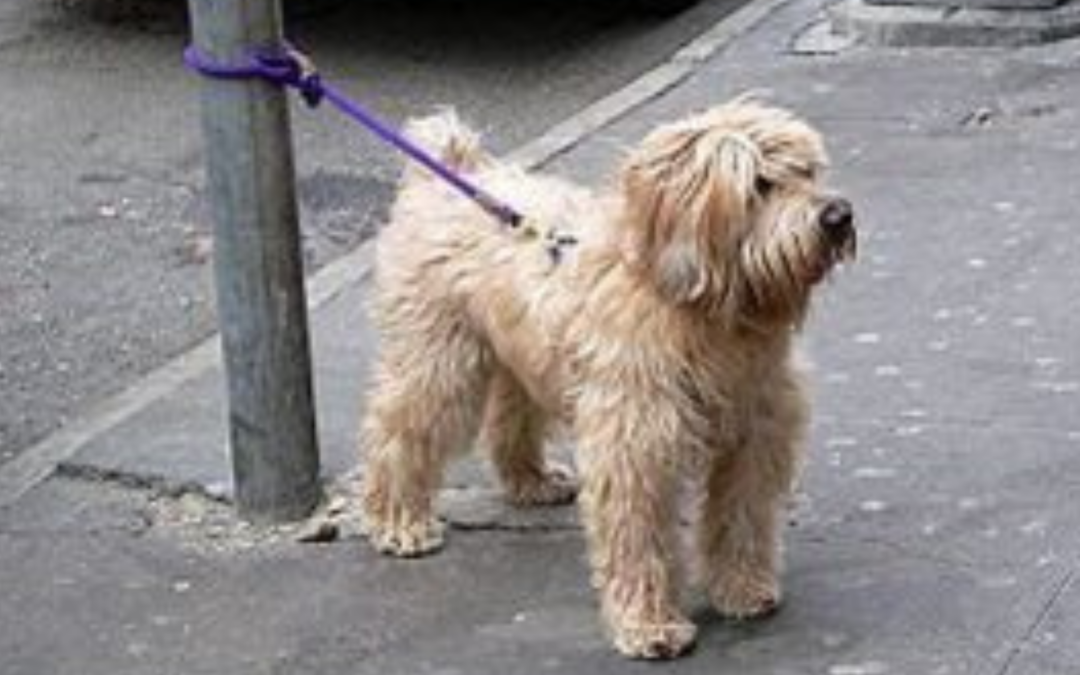A company contacted me regarding their new “safe” harnesses and lead collection, enabling you to leave your dog outside a shop without them being stolen!
This horrified me and I contacted my amazing Dog Trainer, behaviorist, and Canine Expert Witness, Sarah Hursthouse, to share the scary dangers of leaving your dog unattended.
I hope this enlightens you to the scary laws we face as dog owners, it is your responsibility to keep your dogs safe.
Guest Blog from Sarah Hursthouse of Dogskool
If you’re anything like me, your dogs, along with your family, are the most precious things in your life. You couldn’t put a value on them, you’d be devastated to lose them. Why then, do people leave dogs tied up outside shops??? Would that same person leave their iPhone X on the wall outside the shop while they popped in for a pint of milk?
Leaving dogs tied up outside shops is wrong on so many levels
Firstly, they can obviously easily be stolen. Experts have determined that the demand for dogs during lockdown has led to a large increase in dog theft. As people are at home more, they are looking for pets to fill their time. This has massively pushed up the prices of puppies and that has then led to a big rise in the numbers of dogs being stolen. Sadly, in English law, dogs are considered “chattels”, merely a piece of property, and therefore dog theft is not considered a serious crime. A dog stolen from outside a shop will probably never be seen again. It may be used as a breeding machine or even a bait dog for the horrific “sport” of dogfighting.
Another major potential problem occurs if a tied-up dog injures someone. Notice the word “injure”. Not “bite” so a scratch or bruise would be considered an injury. People often see a dog tied up and feel sorry for them. They want to go and say hello. What they might not see is that the dog is actually pretty scared right now. They’ve been left alone, their flight option has been removed and their stress levels are sky-high. A normally well-mannered and friendly dog can react badly when scared and approached by a complete stranger. Any sudden fear-inducing stimulus is processed by a small area of the brain called the amygdala. This causes adrenaline to be released, the heart rate to speed up, increases blood flow to muscles, and creates additional energy through increased glucose levels. When under acute stress, a dog’s (and a human’s!) impulse control system is bypassed and the normal threshold for aggression is lowered.
A dog can also “have a bad day”
Trigger stacking is the term we use to describe a situation where the dog has encountered several negative things occurring at once and it can tip them over their threshold. Hypothetically, perhaps he’s not feeling well, he was scared by a big lorry on his walk and another dog was aggressive to him. All of these things can combine to elevate the stress level to the tipping point.
Part of my job as a behaviourist includes assessing and reporting on dogs who have been seized by the police and/or where owners have been charged with an offence. These are frequently dogs who have caused a very minor injury in a situation where you really shouldn’t blame the dog. So, if your dog is tied up outside a shop, someone approaches and your dog injures that person (maybe even scratching by jumping up to greet them in a friendly way!), you could be charged under the Dangerous Dogs Act.
The original DDA was amended by the Dangerous Dogs (Amendment) Act 1997, which took away the requirement for mandatory destruction. Further amendments then came about via the Anti-Social Behaviour and Crime Policing Act 2014.
The amendments created a new offence for attacks on assistance dogs, an increase in prison sentences for aggravated Section 3 offences (where the victim is injured or killed), a new fit and proper person test to assess the suitability of the person in charge of the dog, abolition of the requirement in Section 3 for it to be in a public place or a non-public place where the dog isn’t permitted to be and it introduced the Householder case defence for Section 3 cases.
Section 3 of the DDA applies to any dog. It asks “was the dog dangerously out of control” ie were there grounds for reasonable apprehension of injury to a person or assistance dog. The following considerations would then be taken into account..
Public interest factors
– Relevant guidance (Defra’s Dangerous Dogs Law: Guidance to Enforcers dated March 2009)
– Any alternative disposal (such as Dogs Act 1871 or an Acceptable Behaviour Contract
– If it is deemed that Section 3 is appropriate, then an offence may have been committed by the owner, or, if different, the person for the time being in charge of the dog (this could be a dog walker?).
This is a criminal offence with strict liability. This means there are no mitigating circumstances unless appealing the sentence. However, a case known as Robinson Pierre of 2013, the judge did acknowledge that Section 3 was not an offence of “absolute liability” and he allowed an appeal where Police Officers had caused the incident in question.
The dog can be seized by the police and held in secure kennels until the case is resolved. This can go on for months, even years, and you are not even allowed to know where your dog is. Sentences can be severe, can be custodial or a significant fine and unpaid work. There may also be a ban on keeping animals where appropriate. The dog can also be made the subject of a Destruction Order.
Many owners will appeal and engage the services of a dog behaviourist to assess the dog and owner and to then prepare a report for the court. If the report deems the dog not to be a risk to the public and the owner is a fit and proper person to be in charge of the dog, the judge can allow the appeal. This means that a Contingent Destruction Order is imposed on the dog which may have certain conditions such as always being on a lead or must be muzzled in public. Tying your dog up outside a shop and leaving them would be judged negatively and cast doubt on your ability to be a responsible owner.
As you can well imagine, this process is lengthy and extremely costly. It will often take many thousands of pounds to get your dog back. Many dogs will suffer untold psychological damage during their time in kennels.
This is a situation to be avoided at all costs. One situation that you can DEFINITELY manage is to avoid tying your dog up outside a shop!
Please be a responsible dog owner and leave your dog at home whilst you visit a shop. Even if you’re only going to be 2 minutes, it’s just not worth the risk!! If your dog struggles when left alone at home, address that problem and engage in some alone training with an experienced and well-qualified dog trainer.

Wow, how did that make you feel?
Did you realise this was the case? Please let us know in the comments.
I highly recommend Sarah Hursthouse of Dogskool, this is a personal recommendation, I have attended many classes over the years, behavioral, fun, agility, puppy and Online classes during lockdown.
When allowed if you are in Cheshire, Stoke-on-Trent, or surrounding areas, then you and your dog can take part in a wide range of classes and training. But online training and video one to ones also available.
And although I hope you never need it, Sarah is a qualified Canine Expert Witness, who can assess your dog and provide the court with a behavioral report.



